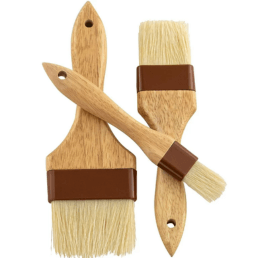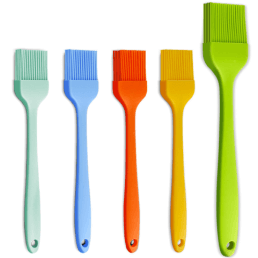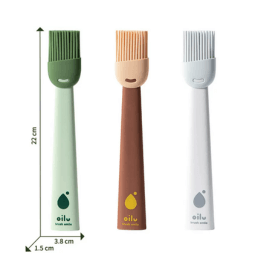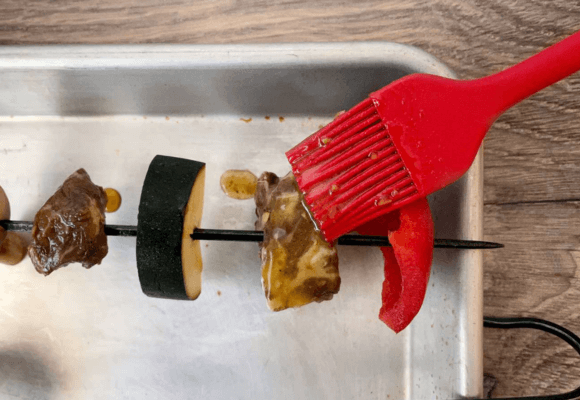Of the many instruments in the kitchen, the most versatile tools are the brushes, which are key to providing color and flavor for several sweet and savory foods. When choosing the right brush, a fine distinction between basting brush vs. pastry brush must be observed closely.
Whether you are baking croissants or grilling ribs, basting and a pastry brush are the most handy kitchen tools required to collect and distribute a sauce or liquid adequately across the food surface.
Differences that stand between a basting brush Vs. Pastry brush has less to do with the composition and more with the utility. So, let’s explore the two distinct types of culinary brushes, unraveling the considerations that must be made when choosing them which help to enhance the richness and taste of your beloved dishes.
Basting Brush Vs. Pastry Brush
Basting brush Vs. Pastry brushes are those brushes that can be used for varying tasks by any professional or home cook. However, what distinguishes these two brushes is the way they are used and for the purposes that they are utilized.
For example, a pastry brush is typically only used for baked goods and pastries. In contrast, a basting brush serves its purpose in cooking savory foods and is primarily used with vegetables and meats.
Nonetheless, basting and a pastry brush are crucial tools that a passionate cook must possess. Something that must be remembered with the brushes is that their use must not be intermixed.
This means that a pastry brush should never be used for vegetables if once used for a baked good, nor must a basting brush be used to coat a croissant if it had been previously used for meat. You would not want the lingering odors and flavors on the brushes to be detected in your baked or grilled goods and ruin the flavor of your dish.
After all, no one would want their salmon to taste like a sweet pastry, and to avoid this cross-contamination of flavors, only a clean brush should be used, regardless of the task you are conducting.
What Is A Pastry Brush?
A pastry brush is a small brush with soft bristles used by chefs to apply glazes, oils, sauces, and other liquids to food items. Traditionally, these bristles used to be made naturally, but with the advent of technology and innovation, they are made of nylon or plastic fiber. A pastry brush is an essential tool in baking, perfect for gently applying glazes or egg washes on slices of bread to achieve that golden, crispy crust.

Whenever shopping for a pastry brush, you must always ensure that the bristles of your pastry brush are soft and not harsh, as then they would scrape away or damage the surface of the dough. Thus, pastry brushes are ideal for delicate foods such as croissants or pastries.
Another thing that can be ensured with a pastry brush used on delicate food items is that the ingredients the cook adds as a coating above the food can be maintained consistently.
With the pastry brush, a coating of melted butter or egg wash can be applied to your baked goods and grease a pan. Additionally, if the need arises to remove a seasoning applied in excess on a dish, a baking brush will be your versatile companion in this challenging endeavor.
What Is A Basting Brush?
A brush that is used to apply sauces or a marination of sauces to a meat or vegetable dish is a basting brush. Unlike a pastry brush, the bristles of a basting brush are made to withstand the high-heat exposure applications they come into contact with when applying thick sauces while the food is on the grill.

Similarly, despite the silicon composition of the basting brush bristles, they are flexible enough. If the brush is large, it can effortlessly coat large surfaces of an expansive, slow-cooking rib recipe.
However, a caution to be adhered to with a basting brush is never to use this brush for a pastry because if used, there will be no way for you to stop the smells and the flavors of the sweet and savory from mixing.
Therefore, the brushes should be kept in two separate corners of the kitchen for a constant reminder of a basting brush specifically used for sauces and marination on poultry, meat, and fish before, after, and during cooking or smoking.
Beforehand, use a basting brush for marination; during the cooking, use the brush to spread a thick layer of your preferred sauce, and later on, remove any excess seasoning that was applied while grilling.
Determinants Of An Ideal Brush
Aside from the differing uses, certain determinants will help you pick the right brush from the two: basting brush and pastry brush. It is established that a baking brush is used for baking applications and a basting brush while grilling.
But certain other factors such as the brush size, shape, details, and maintenance are some things that, when considered, will provide you more clarity in choosing an ideal brush for yourself.
Brush Size
No other more accurate determinant of the versatility of a brush exists other than its size. The size helps approximate how much the brush will hold the liquid and what kind of bristles it will have.

Brushes, small in size, are desirable for a great deal of tasks, which range from applying egg wash on dumplings and glazings on baked goods. They are also ideal for detailed and delicate tasks because small brushes hold minimal liquid and have bristles that do not scratch the dough away from the food item.
Contrary to small brushes, we have large brushes that come with innumerable bristles that are capable of taking in a massive amount of liquid and are used for finishing on sizable surfaces such as ribs that are being grilled.
Most often, large brushes are used by chefs or food service professionals in Restaurants whose cooking operations run on an industrial scale.
Brush Shape
Basting brush & Pastry brushes also come in many shapes, whereby round-headed brushes are frequently used for detailing tasks or plate decoration for small pastries. On the other hand, angled brushes have tapered bristles, and they work best when precise work is to be done in detail. They are also effective if you extend a brush into the oven to glaze any food item.
Brush Handle
One must always choose a brush handle per their personal preference. A brush handle may be made of wood, which is comfortable to hold yet sturdy, or plastic, which is strong, durable, and highly convenient to clean.
Nevertheless, brushes that are designed for grilling, keeping in mind the needs of a griller, have handles that are made to be heat-resistant, and the maintenance is also very doable.
Brush Bristles
Whether it be a pastry or a basting brush, bristles are mostly natural fiber and thin, ideal for all purposes. Traditional food brushes often feature animal hair bristles, prized for their natural flexibility and ability to evenly distribute liquids across various food surfaces. However, a drawback to using such fragile bristles with grilling is that they are not heatproof, but the softness of the natural bristles holds more liquid than the silicon bristles.

Simultaneously, the same bristles also quickly retain odor, meaning their use cannot be varied and must be kept very specific. In contrast, silicone or nylon bristles retain a lot of liquid and offer the same benefits to a user, similar to a brush with natural fibers such as. The difference is silicon bristle brushes can withstand heat.
Maintenance
Fortunately, maintenance of both brushes has been kept very straightforward, whereby the key to cleaning is to wash by hand with soapy water or place the brush in a dishwasher if it is dishwasher compatible.
To clean a brush manually, rinse it under hot water to remove all debris, odors, and flavors. Then, gently, without twisting the bristles, rub it in soap water or dish detergent/liquid detergent. Once you are done, leave the brush flat on a clean surface to be air-dried.
Even if you cannot clean a brush right after its use, leave it soaked in warm water and return to cleaning it whenever possible. One particular aspect you must look for is getting all the oil residue, grease, and food debris out of the brush to prevent contamination.
Conclusion
Basting brush Vs. Pastry brush have no notable differences in their composition apart from their featured bristles. Rather, what makes these brushes different is the tasks that they are used in. Always use a pastry brush for delicate goods and a basting brush for grilling meat or vegetables. With that, never, even mistakenly, interchangeably use the brushes!
Frequently Asked Questions
Is the basting brush the same as a pastry brush?
No basting brush has silicone bristles, and it has been made to withstand high heat temperatures. While a basting brush and a pastry brush serve similar functions in the kitchen, they are not exactly the same.
What is the use of a pastry brush?
Pastry brushes are mainly used for coating or glazing baked goods as this brush’s soft, delicate bristles do not damage or scrape away the dough.
What can you use instead of a pastry brush?
Instead of a pastry brush, you can use a paper towel and spoon first to drizzle a liquid and then use a paper towel to clean off the excess. For simple tasks like greasing pans or applying glazes, a folded paper towel or a clean cloth can be an effective substitute. Just dip it into the liquid, such as butter or egg wash, and apply as needed.
What is another word for a basting brush?
A basting brush might sometimes be also referred to as a pastry brush.Another word for a “basting brush” is a “barbecue brush” or “grilling brush.” These terms are often used interchangeably in the context of cooking, especially when referring to the application of sauces and marinades during grilling or roasting.
